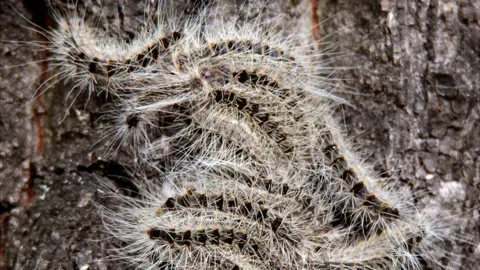Toxic processionary caterpillar plague spreads across Europe
 Getty Images
Getty ImagesGermany and the Netherlands are battling many infestations of oak processionary caterpillars, whose tiny toxic hairs can trigger allergic reactions and skin irritation.
The mild winter and warm spring this year boosted caterpillar numbers.
In Louvain, Belgium, firefighters had to destroy nests of the invasive species before a rock concert.
The caterpillars turn into pupae, then moths in late July, and the threat diminishes.
Germany's western Ruhr region is densely populated and among the worst affected by the caterpillars.
Some schools and parks have been closed to allow specialists to attack the nests in oak trees.
The caterpillars - measuring 2-3cm (about one inch) - march in long processions to the treetops at night, and can wreak havoc in oak trees, as they feast on the young leaves.
One mature caterpillar has up to 700,000 hairs, which can be spread by the wind. The oak processionary moth pest is known as OPM for short.
The Fredenbaumpark in Dortmund was closed for three weeks, as nearly 500 trees were found to be infested there, broadcaster Deutschlandfunk reported.
"The oak processionary infestation this year is very intensive - much more than last year," said the park's manager Frank Dartsch.
Special teams there and elsewhere have donned protective gear and used firefighters' lifts to reach the treetops, where they have attacked OPM nests with blowtorches or big vacuum cleaners.
In the Netherlands, OPM infestations have also increased compared with 2018, with the oak-rich provinces of Noord-Brabant, Drenthe and Overijssel especially affected.
A video of an elderly woman attacking the caterpillars with a heat gun in the city of Enschede has gone viral, the nltimes.nl website reports.
Vasthi Alonso-Chavez, a specialist at Rothamsted Research in the UK, told the BBC that two factors were probably responsible for OPM's spread northwards: the trade in oak plants and a warming climate.
Broadcaster RTL says the caterpillars have spread all over Luxembourg, a heavily forested country. The Luxembourg City authorities have issued a health warning, as the caterpillars are in the city too.
The caterpillars are also infesting the densely wooded French island of Corsica.
They were a problem in parts of England last year.
Ms Alonso-Chavez says there are established OPM populations mainly in London and surrounding areas. OPM was first identified in London in 2006, she says, and probably arrived as eggs on imported oak plants.

'Fat and very full of juice'
The BBC's Matt McGrath on Corsican caterpillars:
Every time we'd open the shutters in our cosy Corsican forest retreat, we'd find them. Fat and very full of juice from months of gorging on oak leaves, these processionary caterpillars seemed determined to share the house with us.
Every day we'd come back and they'd be converging around the doors, eager to get in. Aware of the potential health impacts, we spent a good deal of our time shovelling them up and chucking them back into the trees. But despite their sluggish appearance, the creatures can really shift - turn your back for two minutes and more would appear.
Sometimes the first thing you'd know about an encounter was the soft squish underfoot as you stepped on one in the dark. Relaxing it was not. The owners of the house were not too fussed. It was the second year of a three-year cycle, they explained, and last year was way worse.

Reports from Spain say the oak processionary caterpillars are a problem this year in the northern Asturias region.
Meanwhile, in and around the city of Valladolid, between Asturias and Madrid, pine processionary caterpillars are a bigger problem. They are a similar species, but their habitat is Mediterranean pines, rather than oaks.
What is the risk?
The tiny hairs are carried in the wind and contain a toxin, which can cause rashes, eye irritation, coughing or even an allergic reaction. The caterpillar nests are too dangerous to touch.
The toxin is thaumetopoein, a protein, and hard to counteract as the hairs have hooks that grip the skin. The anti-inflammatory cortisone can provide relief.
Dogs are also vulnerable, as they like to sniff around trees in parks.
What can be done about them?
The caterpillars have some natural predators, including parasites and Calosoma beetles. Few birds, apart from cuckoos and orioles, will touch them.
In some parts of Germany eco-friendly pesticides have been sprayed on oak trees.
Municipal websites in Germany and elsewhere have some advice:
- Clothes and personal effects contaminated with hairs should be thoroughly washed
- Wash yourself thoroughly, including your hair, if you suspect contamination
- Get medical help if you have skin or respiratory irritation
- Visible hairs can be removed with strips of adhesive tape
